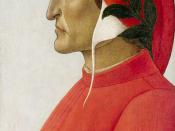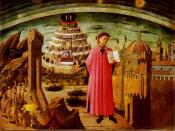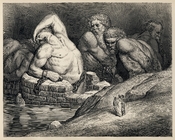Dante's Divine Comedy Dante's Divine Comedy examines the code of conduct proscribed by the Roman Catholic Church during the fourteenth century. Dante said that his purpose in writing his book was to show the living their errors so that they may reform and gain salvation. Many of his moral ideas must be correct, for most are common elements throughout the world's religions, both East and West.
The story begins as Dante awakens in a dark wood after having gone astray from the "straight path" in life. Three beasts, representing malice and fraud; violence and ambition; and incontinence, halt his advance. He turns back and sees the Roman poet Virgil, who is to guide him through the Inferno and Purgatory in the direction of Beatrice, who is acting for the Virgin Mary on Dante's behalf. These two travelers then proceed through the Inferno and Purgatory, at which time Virgil departs and Beatrice guides Dante through Paradise.
While traveling through these areas of the afterlife, Dante discovers those acts punished and those rewarded after one's death.
In Inferno (Hell), those whose sins were less serious were placed nearer the gate of Hell. The first circle of Hades, called Limbo, was reserved for those of the pre-Christian era who were sinless. These were worthy, aside from having not believed in God, though His one prophet was not even arrived yet. These were people such as Homer, Aristotle, Socrates, Plato, and Hippocrates, who were enclosed in a great citadel representing a bastion of learning. The next circle, the first of four punishing incontinences, was designed to punish those who succumbed to their carnal lust, and in doing so discarded reason. Paramount among these are the characters of Homer's The Iliad, Helen and Paris. The third circle of Hell was that of the gluttonous. Dante's...


